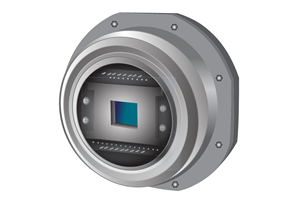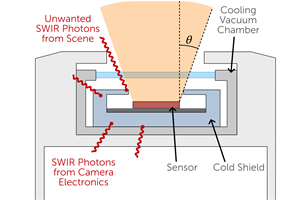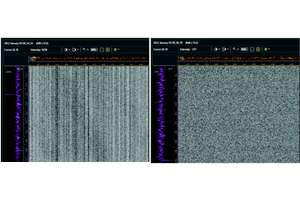Introduction
Infrared imaging in the Short-Wave InfraRed (SWIR) region from 1000-1700 nm wavelength, also known as NIR-II, opens doors to powerful and versatile imaging techniques and applications. This is made possible by InGaAs sensors – sensors where the imaging substrate is composed of a mix of indium, gallium and arsenide instead of silicon. Instead of the <10% quantum efficiency (QE) typical of silicon sensors that vanishes to 0% at 1100 nm, InGaAs sensors can provide >85% QE from 900 nm to 1500 nm.
If only silicon sensors existed, SWIR imaging would not be possible – but compared to silicon-based sensors, the uniformity, read noise and dark current values inherent to InGaAs technology are considerably higher. For all InGaAs sensors, achieving the high image quality and quantifiability required for scientific applications requires far more engineering time and investment. Often, the biggest barrier to achieving sufficiently high signal-to-noise-ratio in scientific imaging is the exposure-time-dependent dark current noise, which is dependent on the temperature of the sensor. Dark current values can range from 10e-/p/s for the world-leading NIRvana LN, up to tens of thousands of e-/p/s for uncooled cameras, both orders of magnitude higher than those expected for silicon cameras. But despite large dark current noise contributions, long exposure times of seconds to multiple minutes are frequently required in SWIR imaging to achieve an adequate signal-to-noise ratio.
Through low dark current noise, high signal collection efficiency, low read noise and reduction in the unwanted background ‘scene noise’ captured by the camera, high-quality scientific InGaAs SWIR cameras can deliver better images with shorter exposure times. To read more about scene noise and how minimizing this enables better scientific imaging, see our technical note on Cold Shielding.
The ultimate determining factor of sensitivity is the signal to noise ratio that the camera achieves, and as is shown in this document, the NIRvana range of cameras provide superior signal-to-noise ratio at practically every imaging condition in scientific imaging.
Signal Collection
Two things determine our signal collection efficiency: quantum efficiency, and pixel size.
Pixel Size
However, a far more significant factor in the sensitivity of InGaAs cameras is the pixel size. Larger pixels can collect more photons. Since noise is introduced per pixel, but detected signal increases per unit area, sensitivity to photons is directly proportional to pixel area.
The 20 μm pixels used by the NIRvana range of cameras provide 1.8x the light collection ability of a 15 μm pixel, and 4x that of a 10 μm pixel. While there is a trade-off for large pixels in image resolution, the primary barrier for most applications in SWIR is sensitivity rather than resolution. For applications where resolution is required, the large pixels can be reduced through use of higher magnification or zoom.
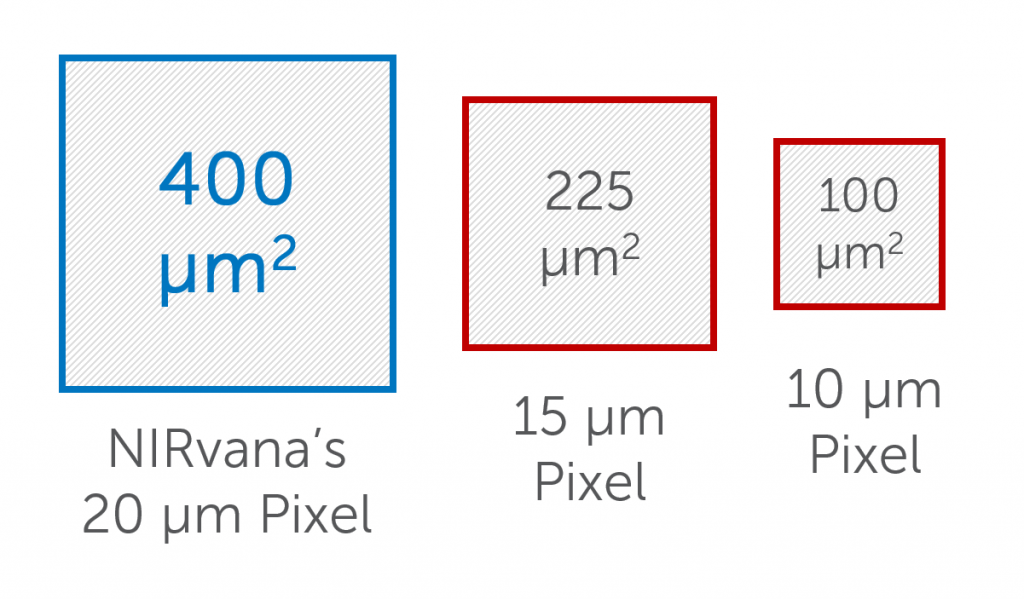
Quantum Efficiency
High quantum efficiency (QE) is essential to capture as many photons as possible per unit area it’s possible to achieve quantum efficiencies as high as 85% across majority of SWIR range, as shown in Figure 1. However, the quantum efficiency of InGaAs, including the wavelength range over which sensitivity can be maintained is slightly temperature dependent. Though as will be discussed in the ‘dark current’ section, liquid nitrogen cooling provides a far greater benefit in the dark current reduction compared to the slightly higher QE of higher temperatures.

Figure 1: Quantum Efficiency curves for NIRvana InGaAs sensors across the SWIR range, showing the influence of sensor temperature.
Dark Current Noise
Often the primary noise source for low light imaging in InGaAs is dark current noise. Camera sensors detect light through capturing incident photons and releasing photoelectrons, through the photoelectric effect. The number of detected photoelectrons in each pixel at the end of the exposure makes up our image. However, incident photons are not the only source of electrons within the pixel. Some electrons within the sensor substrate and the components of the pixel can free themselves through thermal motion and enter the pixel well. There is no way within the pixel to differentiate between photoelectrons, and these ‘noise’ electrons.
This thermal release of electrons occurs randomly, though typically with a well-defined average rate that can differ across the sensor. The net effect is a gradual increase in the ‘dark counts’, the measured signal with no incident photons, for increasing exposure time.
The dark counts (in units of electrons) in a pixel is given by :
Dark Signal (e-) = Dark Current (e- /pixel/second) X Exposure Time (seconds)
Why can’t this increased background count simply be subtracted from the image post-acquisition? In reality, performing this subtraction is essential in imaging with InGaAs due to the high dark current of this technology. But the real cost of dark current is not the counts but in dark current noise. Due to the random timing of thermal electron capture, the total electrons captured is random and follows Poisson statistics; random events with a known average. Like all Poisson behaviors, the uncertainty in the count (the noise contribution) is the square root of the counted events:
Dark Current Noise (e-) = √(Dark Signal (e-)
The solution to dark current formed in this way is cooling. However, there is a unique challenge in SWIR imaging: heat removed from a sensor can move to the surrounding camera body, and cause it to produce infrared photons. These infrared photons will increase the effective dark current of the camera. This is why, along with industry-leading cooling and dark current performance, the NIRvana range of cameras features Cold Shielding to protect the sensor as discussed below, and highly advanced thermal management to reduce the temperature of the camera housing around the sensor.
Read Noise
Another significant source of noise in InGaAs sensors is read noise. Due to the dominance of dark current at longer exposures, read noise is primarily a factor for short exposures, such as those under 100 ms. However, even at shorter exposures, the comparative importance of read noise and signal collection efficiency must be calculated for a given imaging scenario – this balance is given by the signal-to-noise-ratio equation examined later.
Camera specs or sensor specs?
One way in which specification sheet values can sometimes misrepresent camera performance is in the manufacturer’s use of “sensor” specifications. Most InGaAs camera manufacturers do not manufacture the actual InGaAs sensor themselves – instead, the sensor comes from a sensor manufacturer, with everything else from the readout electronics to the cables to the PC handled by the camera manufacturer.
There are some specifications such as Read Noise that are affected by both the readout electronics engineered by the camera manufacturer, and the precise mode of sensor operation chosen. The sensor manufacturer also produces read noise specifications, which typically represent their expected best-case scenario. In reality, these read noise specifications may be surpassed by skilled engineers. However, it is more often the case that camera manufacturers are unable to match the low read noise value of the sensor manufacturer in a real camera. In such cases, it is not uncommon to find “according to sensor manufacturer” in the small print of read noise specifications on camera datasheets. In such cases, the actual performance of the camera will fall short compared to this specification.
Although every camera will vary slightly in its performance, every specification for the NIRvana series of cameras represents the true expected value for Teledyne Princeton Instruments cameras.
Scene Noise
A unique challenge in infrared imaging is that SWIR photons are, in fact, everywhere. We aren’t, of course, able to see them, which prevents us from easily tracing and eliminating background photon sources. But all background light contributes background noise, called “scene noise”, which can in fact outstrip camera noise sources depending on the severity. Indeed, due to blackbody radiation, all room temperature objects are constantly emitting SWIR photons, as are the electronic circuits of SWIR cameras. How do we block these photons from obscuring our intended signal?
The answer is Cold Shielding. By limiting the angles with which photons can reach the sensor to only the frontal angles the sensor is pointed at, extraneous photons from the environment are minimized. Through also blocking around and behind the sensor, infrared photons from the camera electronics and housing itself are also blocked. This cold shield is so named because it is cooled to the same ultra-low temperature as the camera sensor. For more information see our Technical Note on Cold Shielding.
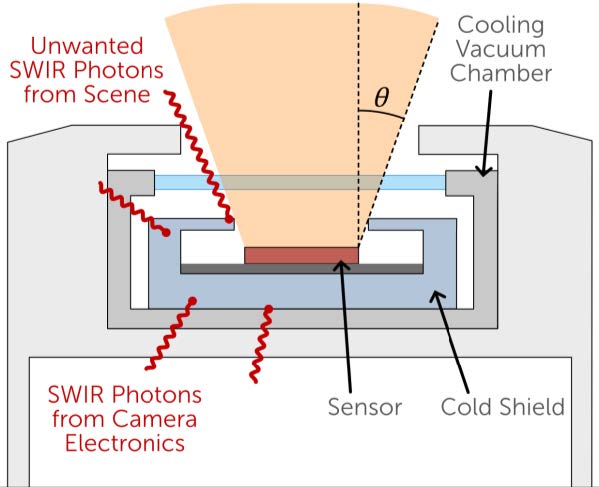
Defining Sensitivity: Signal-to-Noise Ratio
What is the relative importance of pixel size, quantum efficiency, dark current, read noise, and all the other factors above? The answer depends upon your typical exposure time, background light level, and expected photon budget. But all the complexity can be set aside: the Signal to Noise Ratio represents the entire balance of factors with one single number. Equation 1 shows how this is calculated:

Where the first term in the Total Noise represents the total photon shot noise, and:
IS = Irradiance, i.e. incoming signal in (photons / second / μm2)
texp = Exposure time (seconds)
dpixel = Pixel size (μm)
QE = Quantum Efficiency at the detection wavelength of interest
Ib = Background irradiance, i.e. all background signal (photons / second / μm2)
σd = Dark current (e- / pixel / second)
σr = Read noise (e-)
To gain an understanding of the relative importance of these terms, the signal to noise ratios of the three NIRvana cameras are compared to three representative alternative cameras, ignoring the contribution of scene noise from the experimental setup.
Incoming signal is explored over 3 orders of magnitude from ‘high’ signals of 10 photons / s / μm2, which would equate to 4000 photons per pixel per second for the NIRvana cameras, to ‘very low’ signals of 0.01 photons / s / μm2, for which very long exposure times would be necessary to achieve adequate signal to noise. The graphs are shown up to the point where pixel saturation would occur through the combination of collected signal and dark current.
The dominance of low dark current and large pixel sizes is evident in the graphs; the NIRvana camera range offers superior sensitivity in practically every case, with the ultra-low noise NIRvana LN holding a particularly strong lead in all but the highest of signal cases. For the alternative cameras, due to their higher dark current, saturation of the pixel is frequently seen before an adequate signal to noise ratio can be achieved.
In real-life imaging situations, scene noise will be present in almost all cases. The presence of cold shielding in the NIRvana range of cameras will in this case be very likely to significantly increase the lead in signal to noise ratio provided by these cameras compared to alternatives without cold shielding.
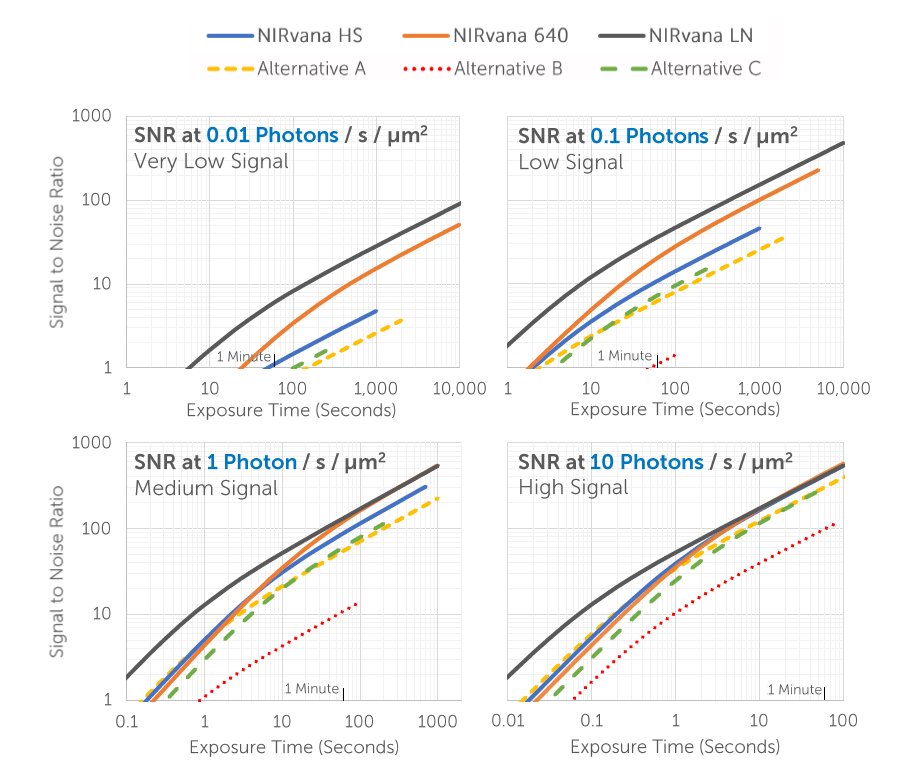

Summary
The NIRvana range of cameras provides superior theoretical sensitivity for practically all low light imaging situations, as shown through the higher signal to noise ratio. However, in real imaging situations the improvement is likely greater due to the NIRvana camera range’s minimization of scene noise through cold shielding.
The large pixels, low dark current, high quantum efficiency and low read noise of the NIRvana range of cameras provide the ultimate tools for scientific infrared imaging. With its industry-leading low dark current from liquid nitrogen cooling and incredibly low read noise from non-destructive readout, the NIRvana LN is the most sensitive SWIR camera on the market. Should incredible dark current performance be required without the complication of liquid nitrogen cooling, the NIRvana 640 stands significantly above alternative cameras. And for a truly versatile combination of high speed, low dark current and superior image quality, the NIRvana HS offers a fantastic balance of sensitivity and cost reduction.

